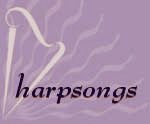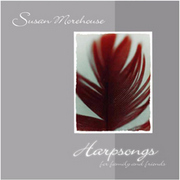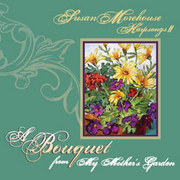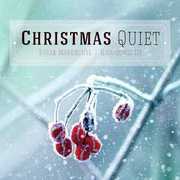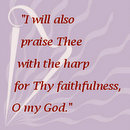Introduction
The harp is one of the world’s oldest musical instruments. References to the harp can be found in the art and literature of most ancient civilizations. As the harp has evolved over the years, the various types of harps developed have inspired beautiful carvings, well-known psalms, and generations of music lovers. Today, the harp is enjoying a renewed popularity and is used not only in classical and Irish/Scottish music, but in blues, jazz, and spiritual music.
The strings
There are many different types of harps. Harps can be strung with wire, nylon, or gut strings. They also come in many different sizes. The smallest harps have about 22 strings and the largest harps found in symphony orchestras have 47 strings. If you look hard enough, you can probably find harps of every size in between! Most harps in use in the United States are organized much like the white keys on the piano. The pitch of the strings are C – D – E – F – G – A – B – C. A color-coding system is used so that the player can locate the correct strings. On most harps, every C is red, and every F is black or blue.
However, if you know anything about music, you will know that sometimes we need to play “accidentals” like C# or B-flat. There are two common mechanisms for providing accidentals – levers and pedals.
Lever harps
The lever harp has a lever located at the top of the string. The lever can be used to change the pitch of the string by pinching the string and shortening it. Thus, a C can be raised to a C# by engaging the lever. Lever harps are a beloved member of the harp family. They have a sweet sound and are easy to transport. The lever harp is the harp of choice for many harp players.
Levers do have two shortcomings. One shortcoming is that the player must use their hand to change the lever. The other shortcoming is each string can only have 2 pitches – the open pitch and the shortened pitch. Both of these shortcomings do not present a problem for most styles of music. However, levers don’t work very well for orchestral music. That is why most orchestral harpists use a pedal harp.
Pedal harps
The pedal harp uses pedals to change the pitch of the strings. There are 7 pedals. From left to right, they are
D C B E F G A
As shown above, there are 3 pedals on the left side of the harp and 4 pedals on the right side of the harp. Most of the time, the left foot works the pedals on the left, and the right foot works the pedals on the right. Each pedal has 3 positions: up, middle, and down. When the pedal is in the up position, the note is flat. When the pedal is in the middle position, the note is natural. When the pedal is in the down position, the note is sharp.
But how does the pedal control the strings? Each pedal is connected to a rod that runs up through the harp column. The rod is connected to a series of links that are connected to pronged mechanisms at the top of each string. Moving the pedal causes the pronged mechanisms to move, which pinches the string and changes the pitch. When the pedal is in the flat position, the string is not pinched. When the pedal is in the natural position, one of the mechanisms pinches the strings and shortens it slightly. When the pedal is in the sharp position, both mechanisms pinch the string, shortening it even more.
Other types of harps (information courtesy of Jo Morrison)
Double-strung, triple-strung, and cross-strung harps are less common in the U.S. You may hear these harps when you listen to CDs or attend concerts.
The double-strung harp has strings that run in two parallel rows.
The triple-strung harp has two parallel rows plus a third row of strings up the center that are the sharp/flats. The third row is slightly offset so that the player hooks their finger between the outer rows and reaches in between the outer strings to reach the accidentals. The triple-strung harp is mainly used in Wales. Robin Huw Bowen is a famous triple-strung harper.
Cross-strung harps are totally different. They also have two rows of strings, but the strings are not in parallel rows. Instead, the strings cross in the center of the harp, just like a big X. The harp is tuned so that the right hand reaches “up” for the naturals and “down” for the flats, and the left hand does the opposite. The advantage of a cross-strung harp is that all of the notes are available to the fingers at all times. The disadvantage is that the space required for an octave is much wider because you have to allow room for an additional 5 strings to vibrate within that octave. This means that you have to stretch your hand much wider to reach an octave. It also means that a cross-strung harp either has a small note range or is very large.
Harp effects
Most of the time, we play the harp by plucking the strings. However, there are other sounds that can be made with the harp. The most common effect is to run the finger quickly across many strings. This is called a glissando. Another common effect is to play a bell-like tone called a harmonic. This is done by artificially cutting the string in half with your finger or hand right before playing the string. It is tricky to do, but it sounds great! Other harp sounds can be created by playing near the soundboard of the harp for a guitar-like sound, or moving the pedals while playing which causes a sliding bluesy sound.
Some final fun questions
Are harps in the percussion family or the string family? Different books give different answers. At first it would seem obvious that the harp would be in the string family. But because we pluck the string rather than bow it, some books say the harp belongs in the percussion family. You decide!
What do you call someone who plays the harp? Some people use the word harper and some use the word harpist. A harp list on the Internet has invented the word harperist so that everyone feels included.
And finally, how long does a harp stay in tune? Until someone opens a door (and the draft changes the pitch).
Credit: With thanks to the Charm City Chapter of the American Harp Society
